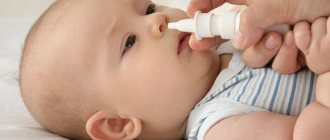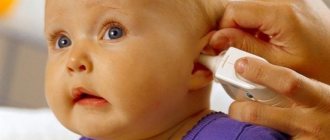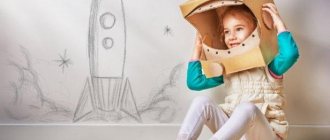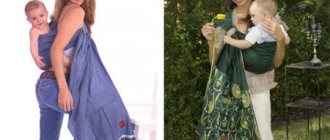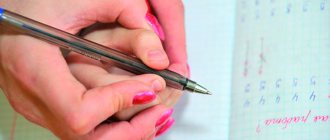Pathological causes
Most often, persistent snot in a child is caused by the following processes:
- adenoiditis - inflammation of the retropharyngeal tonsil;
- otitis – inflammation of the middle ear, from which pathological discharge can easily enter the pharynx and nasal cavity;
- sinusitis - bacterial infection of the maxillary paranasal sinuses (this process practically does not occur in children under 3 years of age, since the sinuses are not yet developed);
- chronic inflammatory diseases of the laryngopharynx;
- frequent colds and weakened immunity;
- prolonged and uncontrolled use of vasoconstrictor nasal drops;
- deviated nasal septum or congenital anomalies in the structure of the sinuses;
- passive smoking – if a child is constantly forced to breathe cigarette smoke.
Depending on the nature of the origin of the runny nose, it can be:
- viral;
- bacterial;
- allergic.
In some cases, inflammation of the mucous membranes in the nose can be caused by traumatic tissue damage, for example, when small toys get into the nose, unsuccessful cleaning, or inserting fingers and sharp objects into the nasal cavity.
Symptoms of a viral runny nose
Ordinary acute rhinitis develops as a result of viruses entering the mucous membranes, which penetrate into epithelial cells and begin to actively multiply there. Often in children, an acute runny nose occurs in parallel with inflammation of the retropharyngeal tonsil (adenoids), tonsillitis, and pharyngitis.
Viral rhinitis is characterized by nasal congestion, abundant clear mucous discharge, redness of the skin around the vestibule of the nasal cavity, and impaired breathing as a result of tissue swelling.
Runny nose of bacterial origin
Bacterial rhinitis is a consequence of a complicated or untreated acute runny nose and is characterized by the addition of a secondary bacterial infection and the development of a sluggish inflammatory process, both in the nasal cavity itself and in the nearby paranasal sinuses.
In this case, the discharge acquires a thick consistency, a yellow or greenish tint, becomes mucopurulent or purulent, and may have an unpleasant odor.
Breathing through the nose is impaired, the child constantly has snot, and during sleep he may snore and cough due to mucus draining down the back wall of the throat.
The inflammatory process alternates between periods of improvement (when the immune system strengthens and is able to restrain further proliferation of microorganisms) and relapse (when, under the influence of external factors, such as hypothermia or too dry air, the defenses are weakened and bacteria begin to multiply again).
Allergic reaction
Allergic persistent runny nose in a child can have either a periodic course or a chronic course, depending on the nature of its origin. For example, if rhinitis is caused by the flowering of ragweed or poplars, then a runny nose will appear in the summer and continue until autumn.
If the allergic form of the runny nose is caused by exposure to house dust, mold (lives in all homes without exception), household chemicals or pets (their fur), then nasal discharge will be constant and year-round with short periods of remission (improvement).
A persistent runny nose of an allergic nature is characterized by the following symptoms:
- itching in the nose;
- severe tissue swelling and inability to breathe normally;
- nasal voice;
- sneezing;
- sore throat;
- lacrimation;
- cough, during which a small amount of viscous, transparent sputum is released.
You can only get rid of allergic rhinitis if you establish the cause of the pathology (carry out a skin test for allergens), and then avoid contact with the pathogen.
How to treat a runny nose in an 8-month-old baby: tips for parents
A runny nose is one of the symptoms of rhinitis (inflammatory damage to the nasal mucosa). In infants, such a banal problem can lead to serious consequences - damage to the sinuses, chronic inflammation, refusal to eat, whims, etc. Therefore, parents should know how to treat a runny nose in a child of 8 months, and how to do it correctly. Revealing secrets.
Causes of runny nose in infants
Otolaryngologists distinguish 3 types of runny nose:
- infectious;
- allergic;
- vasomotor.
However, a runny nose in an eight-month-old child is the result only of microbial inflammation, which in most cases is associated with airborne viruses (50% are rhinoviruses). Therefore, the peak incidence occurs in the cold season.
A cold is the result of an acute respiratory infection.
Allergic rhinitis does not occur in children of the first year of life, because the local immune system of the nose is not yet able to respond inadequately to allergens present in the air.
Vasomotor runny nose develops with an “incorrect” vascular reaction, when the vessels of the submucosal layer either expand or contract under the influence of impulses from the autonomic nervous system.
But in a child it usually finishes forming by the time of puberty. Therefore, vasomotor rhinitis, as a rule, develops at the age of 13-14 years.
Infectious rhinitis in a child goes through 3 main stages:
- Dry stage of irritation. It is associated with the presence of microorganisms on the nasal mucosa. At this time, sneezing, itching in the nose, sneezing appear, and a sore throat also appears. Usually the duration of this stage is several hours, but sometimes it lasts up to 2 days.
- Serous discharge. Inflammation intensifies, so the vessels dilate and fluid comes out of them. “Snot” appears, sneezing intensifies, and nasal breathing becomes difficult. This stage continues until the 4-5th day.
- Mucopurulent discharge. An admixture of pus appears because, against the background of a viral infection, the bacterial flora, which is constantly present on the nasal mucosa, is activated.
Even the most severe runny nose in an 8-month-old child with an uncomplicated course decreases by the 5th day, and completely disappears by the 10th day.
General Treatment Approaches
Treatment of a runny nose in an 8-month-old child is carried out using medicinal and non-medicinal (nasal cleansing) methods. Only their combination allows you to achieve quick and lasting results. Otherwise, the risk of developing such complications increases:
- Sinusitis is an inflammation of the mucous membrane of the paranasal sinuses. It is currently believed that there is no isolated rhinitis. With a viral infection, the sinuses are also involved to one degree or another in the pathological process. If a runny nose proceeds according to the “standard scenario” (it goes through 3 stages of development), and the baby’s body copes with viruses, then sinusitis goes away on its own.
A runny nose in a child is accompanied by transient sinusitis. Therefore, without timely treatment of rhinitis, sinusitis passes from the child into adulthood.
- Transition of acute rhinitis to chronic. Without timely treatment or with improper care, the risk of this complication is 50%. Therefore, it is especially important for parents to know how to treat a runny nose in an 8-month-old child.
Rhinitis is considered chronic if symptoms persist for more than 3 months. Up to 12 weeks we are talking about an acute runny nose.
- Excessive activation of bacterial flora. This can lead to tonsillitis - inflammation of the tonsils, pharyngitis - inflammation of the pharynx, adenoiditis - inflammation of the adenoids, etc.
If the child is 8 months old and the cough and runny nose persist for more than 10 days, this indicates a secondary bacterial complication. Therefore, this condition is often an indication for starting antibacterial therapy. These drugs are prescribed only by a doctor!
Rule #1. Clearing the nose of pathological secretions
A runny nose in an 8-month-old child cannot be cured without mechanical cleansing of the nasal passages. Babies cannot yet blow their nose, so the pathological secretion stagnates. It contains a large number of dead leukocytes and epithelial cells. And this is an excellent environment for pathogenic bacteria living in the nasal cavity. Therefore, the risks of complications increase significantly.
There are 2 ways to clean your baby's nose:
- Manual aspirator.
- Electronic aspirator.
The second option is more effective, because the vacuum created is greater. You need to clean your socks every 2-3 hours.
Rule #2. Rinse your nose with saline solution
Saline solution for infants is available in 2 forms:
- Isotonic – the concentration of sodium chloride does not exceed 0.9%;
- Hypertonic – more salty. This is usually sterile sea water, which is sold in pharmacies.
Currently, doctors around the world believe that aerosols with these solutions are more effective than nasal drops, because... They:
- promote uniform distribution of drug particles throughout the nasal mucosa;
- do not run off after application;
- are less absorbed, which means they last longer.
It is also recommended to use special children's irrigators. These are devices for home use that deliver a stream of liquid into the nasal cavity under low pressure. By liquid we mean a saline solution (isotonic or hypertonic).
You can buy irrigators at the pharmacy. Processes them easily - pour boiling water over the components of the device.
Rule #3. We use decongestants
Relief from saline solutions does not occur immediately. A therapeutically significant effect develops on days 2-3. If a child’s runny nose is severe, then decongestants will come to the rescue. These are vasoconstrictor drugs with local action. They are also available in the form of a spray or drops.
Vasoconstrictor sprays are more effective than drops. In addition, the dose of the administered drug can be clearly determined. The packaging indicates how much active substance will be released with one click on the bottle.
Decongestants constrict the vessels passing through the submucosal layer of the nose, therefore reducing swelling. Within a few minutes after local spraying of the drug, the child feels relief - congestion goes away and the secretion of “snot” decreases.
Source: https://ZdorovyeDetei.ru/uxo-gorlo-nos/nasmork/kak-lechit-nasmork-u-8-mesyachnogo-rebenka-sovety-roditelyam.html
Physiological reasons
A constant runny nose and nasal congestion can also be physiological in nature - this condition is inherent in infants during the period of active teething. As a result of increased activation of the circulatory function in the gums during the period of growth of baby teeth, the blood supply to the ciliated epithelium, which lines the nasal cavity from the inside, increases - this leads to tissue swelling and nasal congestion.
As a result of swelling, a natural defense mechanism is triggered - mucus is intensively formed in the nose to cleanse the cavity of foreign agents. Thus, a long-lasting runny nose in infants during teething is a variant of the norm and does not require treatment.
Parents should carefully monitor the baby’s condition - if a runny nose is accompanied by lethargy of the baby, fever, cough and breathing problems, then they should immediately call an ambulance and “do not attribute the symptoms to teeth.”
Causes of a runny nose in a baby
The most common causes of a runny nose in an infant are associated with improper care, and as a result, a weakening of his immune system. There are 5 main causes of a runny nose in a child, which are arranged in descending order of frequency:
- Physiological - often occurs in a baby before the age of 2-3 months, when his nasal cavity is especially sensitive to external irritants. The process has nothing to do with the causes of runny nose in adults: mucus is formed as a way to protect the sensitive area, this is a completely normal condition for a baby at this age.
- Viral - most often occurs at 3-6 months of life, when the baby’s immunity is especially weakened, but can appear at any time if the child comes into contact with an infected person.
- Bacteriological - often bacteria begin to multiply in the child’s nasal cavity due to improper treatment of a viral or physiological runny nose. A symptom of this is the mucus changing color to yellowish-green.
- Medication - a chronic runny nose can occur in an infant if parents often use vasoconstrictors for no reason. As a result of this approach to treatment, the child’s ability to independently regulate vascular tone is impaired, and the nasal cavity always remains dry. Mucus is secreted as a protective reaction. It is quite difficult to quickly and effectively cure a runny nose in a child caused by drug intervention, so all actions must be carried out under the supervision of a pediatrician.
- Allergic. This runny nose is not common in infants, and should be considered only after all of the above have been ruled out. The most common allergies in children are to dietary components (cow's milk) and household chemicals.
What needs to be examined?
If a runny nose and nasal discharge does not stop in a child for more than 10 days, you should contact an otolaryngologist (ENT). The diagnosis is made based on the history of life and illness, clinical symptoms and the results of additional research methods.
To confirm the diagnosis, laboratory and instrumental diagnostic methods are used.
Laboratory tests include:
- blood tests (general and, if necessary, biochemical);
- Analysis of urine;
- if a causative agent of rhinitis of chlamydial and mycoplasma nature is suspected, a PCR test is prescribed (polymerase chain reaction, which makes it possible to detect the DNA of the pathogen in the blood); bacterial culture of nasal discharge.
Instrumental studies consist of the following procedures:
- rhinoscopy - anterior and posterior, is the most informative method for diagnosing rhinitis and adenoiditis, allows you to assess the stage and degree of neglect of the pathological process, the presence of curvatures in the nose, polyps, ulcers on the surface of the mucous membranes, the phenomena of atrophy and hypertrophy;
- rhinoscopy using an endoscope - carried out if sinusitis and sinusitis are suspected, in case of emergency; during the study, a rigid or flexible probe is used, equipped at the end with an optical system;
- X-ray – it should be done if sinusitis, sinusitis, polyposis and deviated nasal septum are suspected.
Also important is the differential diagnosis of persistent runny nose and nasal congestion in children of bacterial and viral origin from injuries, allergies, foreign objects in the nose, drug overdose - treatment methods will directly depend on this.
What is dangerous about a runny nose in children: the most common complications
Complications of a runny nose usually depend on the disease that caused it and the duration of its course.
- If a child frequently blows his nose into a tissue or tissue, he may develop dermatitis of the nasal vestibule. The skin at the site of friction turns red, becomes swollen and painful. If mechanical irritation is not stopped, small blisters filled with exudate appear. When they burst, they leave behind wounds that can fester.
- A prolonged viral or bacterial runny nose in a child provokes inflammation of the paranasal sinuses - sinusitis. Its main symptoms are heaviness and pain in the frontal region, increased body temperature, and thick nasal discharge. Unpleasant sensations in the nasal sinuses with sinusitis intensify with sudden movements of the head.
- Due to constant nasal congestion, the child begins to breathe through the mouth, the mucus thickens and dries in the lumen of the bronchi, increasing the risk of developing bronchitis and pneumonia.
- Chronic swelling of the nasal mucosa negatively affects the condition of the lungs and can cause the development of bronchial asthma.
- The nasopharynx is connected to the middle ear through the Eustachian tubes. Its prolonged inflammation can be the cause of acute otitis media.
- The proliferation of inflamed mucosa is the main cause of the formation of nasal polyps. Polyps most often form near the ethmoid sinus, closing the nasal passages and making breathing difficult even after the runny nose has stopped.
General principles of treatment
When the mucous membrane of the nasal cavity is inflamed, it becomes severely dry, as the glands actively produce protective mucus. To maintain an optimal level of humidity and local immunity, it is important to regularly moisturize the mucous membrane; for this, special saline solutions are used intranasally (inside the nose):
- Aquamaris;
- Aqualor;
- Salin;
- Dolphin;
- Marimer;
- Physiometer;
- No-salt;
- Humer.
They can be used for any type of runny nose as often as the child’s condition requires, even every hour - the solutions are absolutely safe.
For children under 3 years of age, only drops and sprays under pressure are suitable; it is not recommended to use them due to anatomical features - there is a high chance of infection in the auditory tube (in children of this age, it is thick, short and located almost horizontally).
Inhalation procedures can bring good results. If you have a nebulizer at home, this article is for you.
Atmospheric humidification
In addition, you should carefully monitor the level of humidity in the room; a special hygrometer device will help you with this. It is optimal if the humidity in the room where the small patient is located is 60-65% - this will help prevent the mucus from drying out and the formation of crusts in the nose.
During the heating season, it is difficult to maintain the required air humidity, so use special humidifiers and ionizers or simply hang wet terry sheets over the radiators.
The air temperature in the room where a child with a runny nose is located should not be higher than 18-20 degrees; if it is cool, it is better to put on an additional blouse.
Regular cross-ventilation prevents the proliferation of viruses in the air; it is recommended to do it 2-3 times a day, after removing the child to another room so that he is not exposed to air.
Drinking regime
Pay attention to the drinking regime, since in the acute form of the inflammatory process the body loses a lot of fluid and mineral salts with nasal discharge and sweat during fever.
This is a prerequisite for a quick recovery, especially with a prolonged runny nose.
Warm alkaline drinks (mineral water without carbon), compotes, fruit drinks, tea with lemon, raspberries, linden, honey, rosehip decoction are suitable - they help accelerate the removal of toxins from the body and, accordingly, reduce the duration of the disease.
Walks
As for walks, you should not refuse them if you have a runny nose, if the child feels well and his body temperature is normal. Many parents make the mistake of not letting the patient go anywhere until the rhinitis goes away, which leads to drying of the mucus in the nose, the addition of a bacterial infection and a longer course of the disease. Dress your baby for the weather and walk outdoors as much as possible.
How to properly deal with baby snot
Faced with the problem of nozzles. I looked for treatment methods on the internet, as well as doctors’ opinions. Here's an article I'm inclined to believe. By the way, it also says that a child should not suck out snot with his mouth.
What are the symptoms of a runny nose in a baby? What is a “physiological runny nose”? When is it advisable to start treating a runny nose and with what methods? What should I avoid when treating young children? All answers to these and other pressing questions are in the article by our regular author. Physiological runny nose If the child is under 2.5 months, then a sniffling nose does not necessarily indicate a disease. It’s just that in small children, the mucous membrane begins to work only partially immediately after birth. Only at the age of up to 10 weeks does the mucous membrane of the nose and nasopharynx “turn on” in full force. The body conducts a test. First, the “dry” condition in the nose is checked (usually this goes unnoticed by mothers), and then the “wet” condition. This is where they get scared and begin to treat what is essentially a normal stage of child development. The body knows that it has produced a probable excess of moisture. He must realize it - and then they can intervene from the outside, start “blowing” the child’s nose, rinse the nasopharynx or drip medications. The test is not finished. And after some time, moisture will appear again, and in even greater quantities (after all, last time it was not enough! Everything went somewhere). It turns out to be a vicious circle. That is why, if your child is under 2.5 months old and has a runny nose “suddenly” and there are no additional symptoms of any disease, most likely you have a “physiological runny nose.” Yes, of course, everyone has already understood that in this case the baby does not need to be treated. But the nose is squishing! And it makes it difficult to breathe! We need to help somehow. How can you help your child in this case? Maintaining moisture in the nose, when it is necessary to prevent the mucous membrane from drying out, is considered the main task. At home, cool air is desirable (at temperatures above 22 degrees, mucus dries out quickly) and high humidity. Use a humidifier. Or get an aquarium. Or just place cups of water. Fill the bathtub with warm, hot water and go there to breathe the moist air. Mother's milk. Mother's breast milk contains all the protective substances that a person produces throughout life. Drip one or two drops for 2-3 days. nose There is no need to treat a runny nose; it is a natural reaction of the body that helps the nasopharynx cope with a virus or bacteria. But you need to help your baby so that the runny nose “doesn’t bother you too much.” What to do (General recommendations): Again, maintain humidity. Remember the above tip about breathing moist air in the bathroom? So, go there every half hour, breathe for 5-10 minutes, let the snot liquefy and pour out, then wash the child. You can add a drop of lemon oil with lavender to the water. It would be good to provide comprehensive treatment, because a runny nose usually goes along with other catarrhal phenomena. Therapeutic baths. Herbs: - calendula, - birch leaf, - yarrow, - sage. HERBAL BATH: Equal parts. 50 gr. Herbs for a large bath, 25 for a baby bath. Leave in a thermos for 2 hours. Water temperature is at least 36-37 degrees. Bath for at least 20 minutes. At least 5 days. Directly to the nose The simplest remedy is saline solution. Even if you take half a pipette into each nostril every hour, it is impossible to overdose. WHAT YOU CAN DO YOURSELF : (instead of saline solution) If the pharmacy is far away, or there is no time to run there, you can make a semblance of saline solution yourself: add one teaspoon of salt to one liter of boiled water, or to be more precise, 9 grams . Salt can be replaced with sea salt, but only without additives, preferably food grade. Attention! use saline solution only! for “dripping” into the nose, and not for rinsing the nasopharynx. Under no circumstances should you rinse your child’s nose with a small bulb or enema. In children, fluid passes very easily from the nose into the Eustachian tube, which connects the nose and ear. This can cause inflammation in the middle ear (otitis media). But if you DROP saline solution, nothing like that will happen. The same applies to all other liquids and herbal infusions. BURNING HERBS INfusion: Exactly the same as saline. solution, you can instill an infusion of herbs. Calendula, yarrow. 1 tsp collection or mixture in 1 cup of boiling water and 20 minutes in a water bath. Cool. Place half a pipette into each nostril several times a day. Liquen the snot using the methods described above and remove excess only from the outside. Use a bulb to suction any excess from your nose only before going to bed if it is interfering with your breathing. Attention! If a child has a runny nose (physiological or otherwise), you should not suck out the mucus from the nose. On the contrary, when we have a runny nose, we need to make our nose even wetter! Nozzles are a protection for the poor, small, overworked and irritated nasal mucosa. In addition, intense suction leads to even stronger swelling, which, as you understand, leads to a vicious circle. Moisturizing the mucous membrane. If the runny nose is runny, then the inside of the nose does not need to be lubricated, the mucous membrane is already moisturized. If it doesn’t leak, then lubricate the mucous membrane well so that it doesn’t dry out. For example, peach oil or Vitaon. It is to lubricate it with turunda, and not to bury it, in addition to all the above measures. Supporters of urine therapy. Half a pipette of freshly collected child urine into each nostril, 1 time per day. Medications 1. Salin (saline solution in the form of a spray). Makes it easier to moisturize your nose, but! Very often it leads to otitis due to fluid entering the Eustachian tube. Not recommended for children under 1 year of age. 2. Euphorbium - compositum (spray). A homeopathic remedy that works well to prevent the onset of a runny nose. But! Very often it leads to otitis due to fluid entering the Eustachian tube. Not recommended for children under 1 year of age. 3. Nazivin for babies. Vasoconstrictor drug. At first it becomes very good - the mucus disappears, and then it becomes very bad - swelling of the nasal mucosa begins. It manifests itself like this: the “snot” has stopped running, and nasal breathing not only does not recover, but also worsens (“you can’t breathe”). And to make it feel good again, you have to drip again. And so on ad infinitum. It is acceptable to use at night if a stuffy nose interferes with normal breathing during sleep. 4. Interferon. It is used more as a prophylactic. If you already have a runny nose, it will not help the runny nose. In addition, it very often causes an allergic reaction. Related activities a) Warming ointments and tinctures for heels, wings of the nose and maxillary sinuses: - Calendula ointment - St. John's wort ointment - Vitaon - Dr-Mom (only for heels, tie area) - Pulmex-baby (only for heels and tie area) b) Aromatherapy. Thuja oil - 1-2 drops of oil in a small container of boiling water. Place it in the room where the child is. Tea tree oil - can be used in children after 6 months. 1 drop of oil on your pillow before bed. What NOT to do when you have a runny nose! Under no circumstances should you rinse your child’s nose with a small bulb or enema. In children, fluid passes very easily from the nose into the Eustachian tube, which connects the nose and ear. This can cause inflammation in the middle ear (otitis media). But if, let’s say, saline solution or herbal infusion (let’s repeat it) DROP, nothing like that will happen. If a child has a runny nose (physiological or otherwise), you should not suck out the mucus from the nose. (this was discussed in detail in the section “The nose itself”). Never, under any circumstances, drip antibiotic solutions into your nose! It is unacceptable to constantly use vasoconstrictor drops (naphthyzin, galazolin, sanorin) for a common runny nose. Only before bed, with severe nasal congestion.
SOURCE https://www.parenting.ru/s.php/1272.htm
Drug treatment of bacterial rhinitis
Among medicinal solutions for the treatment of rhinitis, drugs of general (systemic) and local action are distinguished. For symptomatic therapy and relief of nasal breathing, vasoconstrictor nasal drops are used:
- Otrivin;
- Rinazoline;
- Farmazolin;
- Naphthyzin;
- Nazivin.
It is recommended to use nasal drops with a vasoconstrictor effect for no longer than 3-5 days and no more than 2 times a day, since the drugs quickly become addictive, which requires a constant increase in the permissible dose and increases the risk of overdose and side effects.
For detailed information on this group of medications by age, read here.
Among the nasal drops with a therapeutic rather than symptomatic effect are:
- Eucazolin is a drug containing menthol, eucalyptus and peppermint that promotes rapid regeneration (healing) of mucous membranes, creates an invisible protective film on the surface, reduces the risk of infection spreading to the larynx and trachea;
- Pinosol - similar in composition and action to Evkazolin, can be used to treat children from 3 years of age;
- Protargol is a drug based on colloidal silver, used to treat a runny nose of a bacterial nature;
- Collargol is a drug analogue of Protargol, used for the treatment of rhinitis and adenoiditis in children as part of complex therapy;
- Polydexa with phenylephrine is a complex therapeutic drug that simultaneously relieves swelling of the mucous membranes, facilitating nasal breathing, and destroys bacteria (suitable for the treatment of rhinitis of bacterial origin and complicated forms of the runny nose with the addition of secondary bacterial flora);
- Isofra is a drug for local use in otolaryngology from the group of aminoglycosides, the main active ingredient of which is the antibiotic framycitin. The medicine is effective for rhinitis of bacterial origin, sinusitis, and sinusitis.
Before using any drops and sprays, it is advisable to rinse the nasal cavity with the saline solution described above, or your own preparation at the rate of 1 teaspoon of salt per 0.5 liter of warm water.
The procedure is especially necessary in the presence of abundant thick or dry snot, otherwise the medicine will not reach the mucous membranes and will not bring a positive effect. For a complete guide to all types of baby drops, read here.
If a child has a stuffy nose, first you need to use vasoconstrictors, and then medications. When the patient is too small and cannot blow his nose, it is necessary to suck out the nasal mucus mechanically. How to do this correctly - read this article.
Treatment of a persistent runny nose in a child
Try to get a consultation with an ENT specialist, and do not independently treat green snot in a child. Follow strictly the treatment regimen prescribed by the doctor. Treatment will be selected taking into account the age and condition of the child.
How to treat lingering snot in infants
First of all, treatment should begin with cleansing the nose. To do this, drop 1-2 drops of saline solution into each nostril, which you prepare yourself or purchase at the pharmacy. The crusts are softened and removed from the spout.
If the nose is very stuffy, use 0.01% Nazivin or other oxymetazoline-based drugs.
From five months of a child’s life, pediatricians recommend using the Otrivin baby . This is a very convenient product that helps to clean and moisturize the nose with salt drops, as well as suck out nozzles using an aspirator. The system also includes replaceable attachments. You can learn the correct technique using video lessons, such as this one.
After using the Otrivin Baby system, the doctor may prescribe vasoconstrictor drops, such as xylene or vibrocil. These drops relieve swelling and improve nasal breathing. Vibrocil has an additional property - antiallergic. This makes it possible to treat a combined lingering runny nose when the baby suffers from allergies.
All vasoconstrictors are prescribed only by a pediatrician or pediatric ENT specialist. An overdose of these drugs is fraught with unpleasant and dangerous complications.
Under no circumstances should you drip breast milk into your nose. This “treatment” is an excellent environment for the proliferation of pathogenic microflora, which causes purulent processes in the nasal cavity and the spread of infection.
When the viral origin of a persistent runny nose is proven, interferon drops are often used. They are prescribed 2 drops three times a day. The most commonly used is influenza. Before using interferons, do not forget to first clean the baby’s nose with saline solution and suck out the mucus with an aspirator.

Some parents already use beet, aloe, and Kalanchoe juices from 8–9 months. But, most likely, the doctor will not offer them, especially in cases where there is diathesis and other allergic reactions in the baby.
Although it would be unreasonable to refuse these remedies if the baby is not allergic. In this case, simply dilute the juice with warm boiled water in a 1:1 ratio and drop 2 drops three times a day.
All warming procedures for lingering green and yellow snot require consultation with a doctor. A direct contraindication to them is purulent processes in the nasal and other sinuses.
Treatment of prolonged runny nose in infancy has its own characteristics and requires special vigilance of parents. Read a few rules to help avoid harming your baby:
- follow the exact prescribed dosage of medications (do not use 3 drops if 2 are prescribed);
- do not use sprays on infants;
- remove the pacifier from your mouth when sucking mucus from the nose;
- to clean the nose, use flagella, aspirators, mini-syringes;
- the solution for instillation should be at room temperature.
How to properly treat a persistent runny nose in infants
https://www.youtube.com/watch?v=4fIBnajW_Fc
Treatment of rhinitis of viral etiology
If a runny nose of a viral nature does not go away, the child is prescribed antiviral drugs for local use in the form of drops (Grippferon - a solution for intranasal instillation, IRS-19 spray, can be used from birth, Groprinosin from 3 years, Tsitovir 3 syrup from 1 year) and for rectal use in the form of general-action suppositories (Viferon, Laferobion, Interferon).
These drugs not only intensively fight viral infection in the body, but also stimulate the immune system to produce its own interferon, which significantly increases the body's resistance and reduces the risk of complications.
Therapy for allergic forms
Treatment of allergic rhinitis differs significantly from viral or bacterial, since these drugs are not used. An exception is vasoconstrictor nasal drops, which help ease breathing and slightly relieve tissue swelling.
The basis of therapy are sprays for intranasal use, which contain hormonal components. These are dosed drugs of local action, which are almost not absorbed into the general bloodstream; therefore, the risk of side effects is minimal if the dosage and rules of use are observed.
Effective and common drugs in pediatric practice are:
- Nasonex and analogues;
- Avamis;
- Baconase;
- Flixonase.
Hormonal drugs for the treatment of allergic rhinitis can only be used as prescribed by a doctor, if there is really a need for it. Self-medication often leads to severe side effects such as atrophy of the nasal mucosa, nosebleeds, and fragility of blood vessels.
In the treatment of persistent runny nose in children of an allergic nature, it is important not only to suppress the symptoms with hormonal drugs, but to establish the cause of the development of rhinitis and, if possible, eliminate the baby’s contact with the irritating component.
Transparent snot in a child: how to treat it?
Before treating clear snot in a child, you need to show him to a doctor, who will find out the exact cause of its occurrence. Regardless of the etiology of the runny nose, its treatment necessarily includes the procedure of cleansing and rinsing the nasal canals.
Washing baby's nose
If a child has snot that resembles water, then a nasal aspirator . If the mucus is too thick and viscous, then it must first be liquefied with saline or a decoction of medicinal herbs, using St. John's wort, chamomile or sage for its preparation. For these purposes, you can also purchase a pharmaceutical saline solution:
- Humer;
- Dolphin;
- Aqualor;
- Salin;
- Aquamaris.
A few drops of decoction or freshly prepared solution are instilled into each nasal canal, after which the diluted secretion is sucked out using an aspirator.
Any procedures that are carried out using nasal drops or sprays are carried out only after thorough cleansing of the nasal passages. When a small child learns to blow his nose on his own, he will need to be constantly reminded to do it himself.
Treatment of a runny nose with acute respiratory infections or acute respiratory viral infections
Liquid transparent snot in a child who has fallen ill with a viral infection or acute respiratory infection, after some time is replaced by thick discharge. Treatment of such a runny nose should be carried out only with strict adherence to bed rest.
A runny nose of any etiology, which is accompanied by the release of a transparent mucous secretion, should be treated with vasoconstrictors (Nazivin, Nazol, Rinonorm, Vibrocil, Naphthyzin, Galazolin, Sanorin). Such medications alleviate the patient’s condition and reduce the amount of mucous secretion only for a while. They cannot cure a runny nose. It is recommended to use them no more than seven days .
Treatment of liquid mucous discharge during the first three days after the onset of the disease is carried out using human interferon preparations. These include Grippferon and Interferon. Clear snot in the form of water can be treated by inhalation using a nebulizer charged with an interferon solution.
Infectious rhinitis is usually treated with immunomodulatory drugs. Sinupret is considered the most effective - a drug that consists of natural ingredients.
With ARVI, natural recovery usually occurs faster if the child is provided with access to cool and fresh air, as well as a normal drinking regime. becomes thick after a very short time , making it difficult to breathe through the nose and increasing the risk of spreading the virus, as well as the addition of a secondary bacterial infection.
Treatment of allergic rhinitis
If a child’s liquid transparent snot occurs as a result of an allergic reaction, then it is necessary to find out which allergen contributed to its development.
Treatment of allergic rhinitis is carried out with antihistamines in compliance with strict dosages. Before doing this, you should definitely consult an allergist, who will select the right drug. An advanced disease can cause the development of bronchial asthma .
Thus, clear snot in a child may indicate either the presence of an infection in the body or be a reaction to a certain allergen. The baby needs to be shown to a doctor who will conduct an examination, make the correct diagnosis and prescribe appropriate treatment.
A runny nose in a child can be infectious, allergic or neuro-reflex in nature. The membranes of the nasal passages actively produce mucus, which leads to nasal congestion, sneezing, watery eyes, headaches and general malaise. We tell you how to determine the cause of a runny nose in a child, how it can be dangerous, and how to cure it.
Physiotherapeutic treatment of persistent runny nose
In combination with drug treatment methods, physiotherapeutic procedures are used to eliminate chronic runny nose. They are prescribed only by a doctor and are an effective aid in therapy, and in some cases replace it:
- Laser therapy - under the influence of a laser beam, modified and thickened blood vessels are destroyed, which can intertwine with each other and interfere with full nasal breathing. During the process of regeneration of the mucous membranes (healing), new vessels are formed through which blood circulates better, thereby reducing the severity of swelling of the epithelium of the nasal cavity.
- Ultrasound treatment – when using ultrasound of a certain frequency, it reduces the volume of the mucous membrane of the nasal cavity, thereby removing swelling and restoring full breathing.
- Tube-quartz – ultraviolet irradiation of the mucous membranes of the nasal cavity and pharynx. This procedure helps destroy bacterial flora, relieves tissue swelling, and reduces the severity of the inflammatory process.
Physiotherapeutic treatment is carried out for children only after the acute inflammatory process has subsided, otherwise the risk of complications and adverse consequences of the procedure increases.
Treatment of a constant runny nose for children also involves a complex effect on the body of hardening procedures, breathing exercises, exercise therapy, and a rational balanced diet - all this helps to increase the defenses and strengthen the immune system.
[Pediatrician consultation] Prolonged runny nose in children
